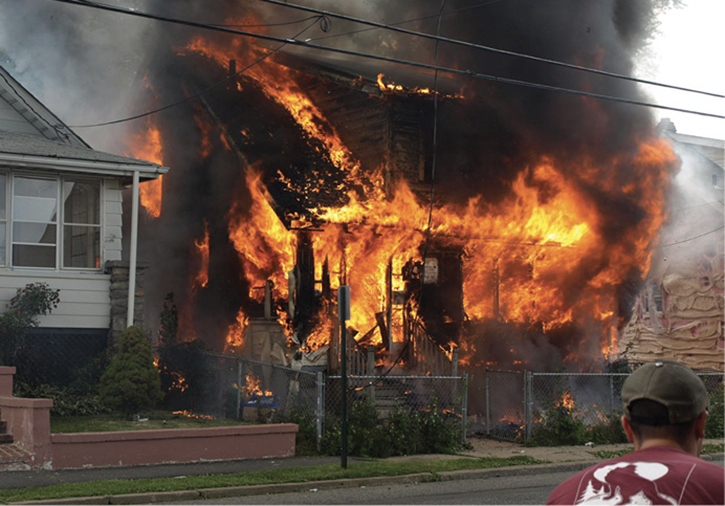
Suburban engine company (SEC) officers and members are called to all kinds of alarms: structure fires, wildland urban interface, medical calls, hazardous materials, extrications, flammable liquids, wires down, natural gas emergencies, carbon monoxide calls, the list seems endless. This article provides valuable tools for planning for and directing tactical operations and leading, managing, and supervising your SEC to ensure fireground success while maximizing efficiency and increasing the safety of your members.
Mission-Essential Tasks
Our military leaders use a leadership tool called the mission-essential task list (METL), which, as its name implies, is a list of the most important tasks necessary to effectively complete your defined mission. The first step in developing the METL for your SEC is to determine your missions—those alarms your SEC responds to and mitigates. Then, conduct a threat analysis of those alarms and an overall hazard analysis for your area of responsibility.
Threat analysis generally consists of two main parts—the most likely threats and the most dangerous threats. In other words, what can you expect to respond to on a recurring basis (your most likely threat/alarm) and your most dangerous type of alarm (those with the greatest life hazard and property loss potential)? Rule out hazards/tasks you cannot perform because of funding, personnel, or equipment shortfalls. You will rely on mutual aid for them; they may include specialties such as hazardous materials response, swiftwater, high-angle rescue, and structural collapse alarms.

(1) House fires are our most important alarms. (Photos by author.)
U.S. Army General Bruce C. Clarke recommends the following when developing an METL: “Do essential things first. There is not enough time for the commander to do everything. Each commander has to determine what is essential and assign responsibilities for accomplishment. He should spend the remaining time on near essentials. This is especially true of training. Nonessentials should not take up time required for essentials.”1
Residential Fire Most Important Mission
The residential fire is both the most likely threat (life and property) for the SEC and the deadliest threat. Nationally, the data shows that house fires are responsible for the vast majority of structure fires, injuries, deaths, and property loss each year. According to the National Fire Protection Association (NFPA), in 2018, 65% of all fire deaths occurred in one- and two-family homes (an increase of 3% from 2017); they caused 74% of all civilian injuries and $8 billion (72%) in property losses. It can be argued that strategic and tactical efficiency at residential fires is about 75% of the total mission of the SEC. Of the 387,000 residential fires in 2018, the NFPA reports that 276,500 occurred in one- and two-family homes. The next closest property type was apartment fires at 86,500.
Let’s focus on the house fire, which is clearly an “essential task” for the SEC. Then, we will examine “near essentials” or the other 25% of our mission.
Without a doubt, the SEC’s most important task is to get water on the house fire quickly for life safety and property conservation. Our overall mission is to save lives and property. The best way to do that is to get decisive amounts of water on the fire quickly. This is where most of your effort, money, training, and leadership emphasis should be directed. Your house fire METL can be summarized as follows:
- Aggressively attack the fire with decisive target flows for 1¾- and 2½-inch handlines and master streams.
- Quickly establish a reliable water supply through hydrants, draft sites, or tanker shuttles.
Specified and Implied Tasks
Mission statements contain both specified and implied tasks. Specified tasks include stretching and operating the line in an aggressive interior fire attack and establishing a reliable water supply for that attack. There are many implied tasks or supporting tasks that make these larger, specified tasks/goals possible. For the SEC, some of the most important implied tasks are discussed below.
Figure 1. Flowmeter and Pressure Gauges During a Flow Test for Any Size Hoseline3

Fire Attack System. We must think of, plan, and evaluate our engine company (hardware, engine hose and nozzle, software, members/training) as a fire attack system. It includes everything from the water supply to the nozzle that plays a critical role in delivering decisive amounts of water to the fire: water supply (hydrant, draft, tankers), supply line, pump, pump operator, hose, nozzle, and engine crew. Like links in a chain, a single failure results in total mission failure or at least a delay in fire suppression and an increased threat.
Engine Design. Design your engine, hose loads, and stretches to maximize speed and minimize your crew’s effort. You want to get the line off the rig quickly and easily so the crew can spend the majority of their physical effort on aggressive interior fire attack. Engine design can have a huge positive or negative impact on your effectiveness. Often, this comes down to the simple design of your hosebeds: Keep them low so members can reach all the lines from the ground.
Target Flow. SEC success is based on establishing target flows for your fire attack in small, medium, and large quantities to meet respective fire conditions. Small is the 1¾-inch line for aggressive interior attack, the 2- or 2½-inch (medium) for heavy fire attack, and large flows from portable master streams for high hazards or defensive operations. The target flows you choose are up to you; the important point here is that your engine company’s implied task is to be able to flow all of these effectively and efficiently every time your engine goes to work. As a good general rule, target flows, respectively, should be 180, 260, and 500 gallons per minute (gpm). However, it is your engine company, and your target flows must be directly related to the hazards in your area and the amount of nozzle reaction with which your members can safely operate.2
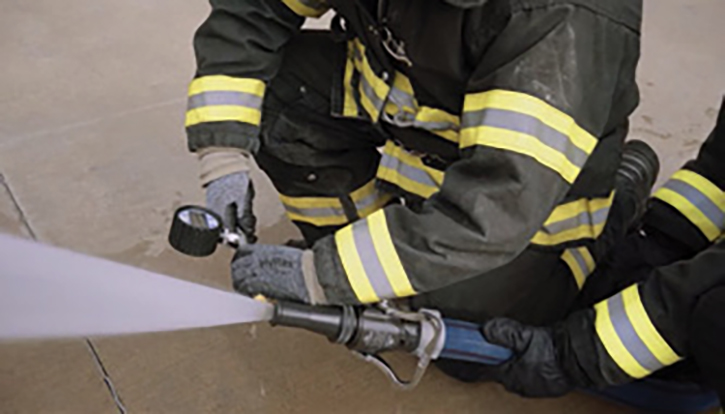
(2) Using a pitot gauge to measure nozzle pressure during a flow test.
Testing for Target Flows. You need to measure the performance of your fire attack system to see if you are achieving your flow goals. You can’t tell how many gpm are flowing no matter how good you think your eyes are. Start with your first initial fire attack line (1¾-inch). Learn to test the flows with this one line, continue to adjust the fire attack system for this one line, perfect it, then move on to the next larger line and use the same system and testing process.2
There are many variables, including incorrect pump pressure, engine valves not opening completely, relief valve prematurely opening or set too low, high friction loss in poor-quality or old/damaged hose, kinks, incorrect smooth bore nozzle size, and nozzle (valves) not opening completely and not functioning (lack of annual testing/maintenance), but automatic testing is relatively easy (Figure 1).
For smooth bore nozzles, if you use a pitot on the line when it is flowing to determine the nozzle pressure and you know the orifice size, simply go to the charts and determine the flow. The pitot verifies the flowmeter reading (photo 2).
If you place inline gauges at the pump, 100 feet downstream, and at the nozzle, you can demonstrate and measure the friction loss in that line to better determine the correct pump pressure. Of course, the gauge at the nozzle will tell you the nozzle pressure as well. Note that I said “determine,” not “calculate.” Calculations are theoretical flows, and we need to understand them to understand hydraulics. Because of the aforementioned variables, measure and determine correct pressures; don’t calculate theoretical flows that you likely will not achieve.
Using a flowmeter at the discharge side of the pump also helps measure and provide a second measurement to verify the other numbers you are seeing while flow testing. Be sure to calibrate your flowmeter before you begin.
Kinks can affect your target flows as well. Just as you need to do with the target flow, you need to measure the effect of different kinks on your system. For example, an automatic nozzle will suffer a much greater loss in flow than a smooth bore when the same kink is present.4
Leadership METL
You have a well-designed engine (hardware) that allows you to stretch and operate your lines effectively with your existing crew (software). You flow-tested your fire attack system and you know from training and annual flow tests that you hit your target flows for whatever line you choose based on fire conditions. Now, it is time to move on to considerations that will help you to lead your company to achieve fireground tactical success.
Train your members to understand the complexities of modern house fire development. The fire triangle is Stone Age. It is the most basic level of understanding fire. We don’t go to basic fires. We go to fully developed, ventilation-limited, wind-driven, pre- and post-flashover, and fast-moving aggressive fires. We should be training so our leaders and members understand at least the 10 factors shown in the Fire Decagon (Figure 2).
Figure 2. The Fire Decagon
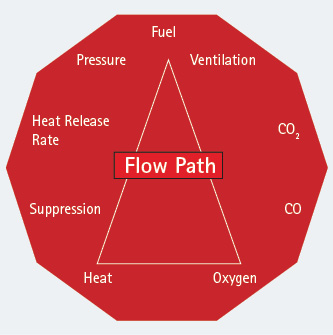
Source: Author
The Fire Decagon incorporates the 10 factors necessary for understanding modern fire dynamics. The recent Underwriters Laboratories (UL) study, Impact of Fire Attack Utilizing Interior and Exterior Streams on Firefighter Safety and Occupant Survival, contains a wealth of up-to-date information on residential fire development and fire attack and excellent training material on house fires for SEC officers and members. Even if you disagree with the recommendations, view the data, videos, and thermal imaging camera views from the live burns. Additionally, there are excellent free training programs online for honing your strategic and tactical skills as a leader.
For the safety of members and tactical efficiency, officers and members must fully understand modern fire dynamics in private dwellings. This is critical for officers to size up and direct operations and for firefighters to be able to recognize dangerous conditions before they are caught in them. We know our turnout gear will not protect us from the nearly 2,000°F temperatures of a residential flashover and that our skin burns at a mere 130°F. Combine this information with the fact that our most important personal protective equipment and self-contained breathing apparatus lens will fail around 400°F. Train your members to monitor conditions for the warning signs to help prevent them from getting caught in these deadly situations.
Transitional Attack
Applying water from the outside of a structure is not new. It has a new name. It used to be called the “blitz attack,” whose goal it was to knock the fire down before we entered the structure. Captain Bill Gustin, Miami-Dade (FL) Fire & Rescue, talks frequently about how his father, a Chicago Fire Department engine firefighter, would “give it a dash from the outside before he went in.” Certainly, this would not be done at every fire and may not even be our first choice; but when faced with delayed entry by the truck, heavy fire conditions, or limited personnel or other obstacles, it may be a good option. It is critical to remember not to grow roots on the sidewalk; a transitional attack requires an immediate interior aggressive follow-up by the attack team after the “dash from the outside.”
When our understanding of fire dynamics was the fire triangle or, on a good day, the fire tetrahedron, we also lived by the 20-minute rule: In a house fire, firefighters had 20 minutes before they had to concern themselves with structural weakening. We could get inside and go mano-a-mano with the fire (after all, it is what we live for!), take a beating, and hopefully win what the late Chief Alan Brunacini affectionately called firefighting—”a mutual murder contest.”
Chief (Ret.) Peter Van Dorpe, Algonquin-Lake in the Hills (IL) Fire Protection District, in his videos in support of cooling from a position of safety, further argues that applying water from the outside followed by an aggressive interior attack is the most aggressive form of firefighting.
Consider this statement in relation to the following facts: Modern homes are not built to withstand a fire load, and trusses, I-joists, and laminated beams and metal framing fail quickly when exposed to fire. UL reports that 12-inch wood I-joists, unprotected by gypsum board, will fail in approximately six minutes. In live fire testing, legacy floor joists failed at about 17 minutes under the same fire conditions.5
Factor in the volatility of the smoke and the high heat release rate of synthetic home furnishings, and we see fires going to deadly conditions much faster than ever. Consider your position as an aggressive interior firefighter: Would you rather be caught in heavy fire conditions during a Mayday, or would you have been better off if you had knocked down the fire before you entered the structure?
Clearly, the transitional attack is not the silver bullet for every fire, and it is absolutely critical (if you use it) to immediately get inside after you knock down the fire from outside. It is a valuable tactical option, especially in low personnel, delayed entry, or other circumstances. Think of the alternate option: letting the fire burn uncontrollably with a charged line in our hand. That will not work well for the victims or the property owner.
Suburban Tactical Adjustments
There are two recent changes in construction that we must recognize because they necessitate tactical changes and result in rapid fire spread that exceeds even that in legacy balloon construction: outside building materials and modular housing.
Fire envelopment. This occurs when flammable building materials on the outside of a house burn with access to an unlimited amount of oxygen. A fire of exterior origin or fire from a simple one-room fire that has extended out a single window will quickly involve flammable vinyl siding, foam insulation, house wrap, and then the chip board sheathing (photo 3). Fire races up the exterior, can penetrate upper-floor windows, and almost always enters the attic through vinyl soffit vents. The tactical adjustment here is to extinguish the exterior fire first, to prevent members from getting trapped by both interior and exterior advancing fire that are supported by huge fuel loads and unlimited air. Consider the rapid fire growth with fire out a window on one or two floors and the flow path created when we enter the front door. Lots of fuel both inside and outside and lots of air mean lots of fire very quickly.6
Modular. The second major change is the widespread use of modular constructed homes. Chief Kevin Gallagher from the Acushnet (MA) Fire & EMS Department provided excellent insight into this unique hazard at FDIC 2015. He noted that there is a 21-inch gap between the first-floor ceiling joists (top of the bottom module) and the floor joists of the upper-floor module. This space and the fact that often the first-floor ceiling (gypsum board) is glued—not screwed—to the ceiling joists allows a simple room-and-contents fire to melt the glue. The ceiling fails and allows fire into the void that runs the length and depth of the home. The home quickly becomes fully involved.7
Master Streams
Aggressive interior fire attack with handlines solves 90% of our working fires. Jeff Shupe, a highly experienced engine company firefighter (ret.) from the Cleveland (OH) Fire Department, emphasizes the need for the SEC to be proficient in aggressive interior fire attack and in three mission-essential tasks that General Clarke may consider “near essentials”:
- supplying master streams,
- supplying attack engines with water, and
- supplying fire protection systems.
We all think about using our master streams for defensive operations—saving the neighborhood. But, the SEC must master the skill of rapid offensive application of large flows through master streams: 2- or 2½-inch handlines or portable master stream devices. This skill is especially important if you are running with understaffed engine companies. Think of it as “gallons per member” and try to maximize it. Members must be trained, and your rigs must be set up to use portable master streams as rapid offensive tools to deliver high-volume flows when confronted with large bodies of fire.
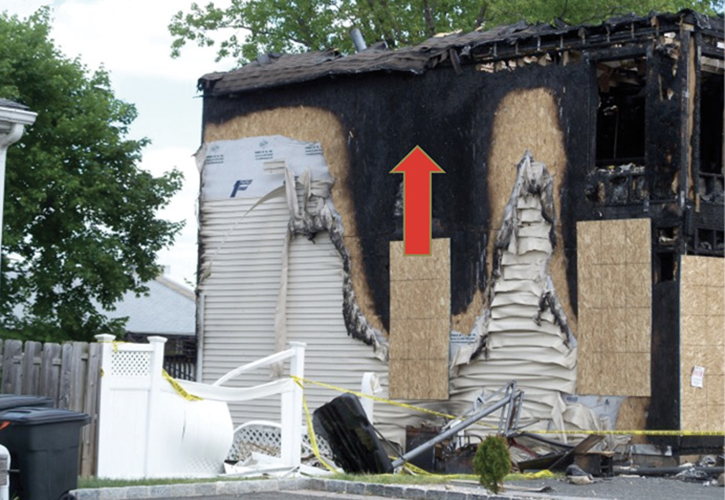
(3) Rapid fire on the exterior of this structure resulted in the collapse and burning off of the roof.
Shupe shows how one firefighter can aggressively deliver 500 gpm thru a portable master stream for heavy fire conditions. After the immediate fire area is knocked down, your engine company can move this line inside to attack more fire or attach a smaller handline to it to control spot fires.
High-Flow Hazards
Every fire department has high-flow target hazards. Another near essential task that will pay off big is to preplan how your SEC will flow high volumes of water. Use aerial photos with call-outs to help develop and test your plan. While preplanning for the industrial complex in Figure 3, we learned that if we flow nearly 2,000 gpm from the two closest hydrants, the water company tank supplying this water district will last only about two hours. Several of the next closest hydrants are off the same system, so if second-due units use them, they take water from the first-due units engaged in the original firefighting operation.
Figure 3. Preplanning an Industrial Complex
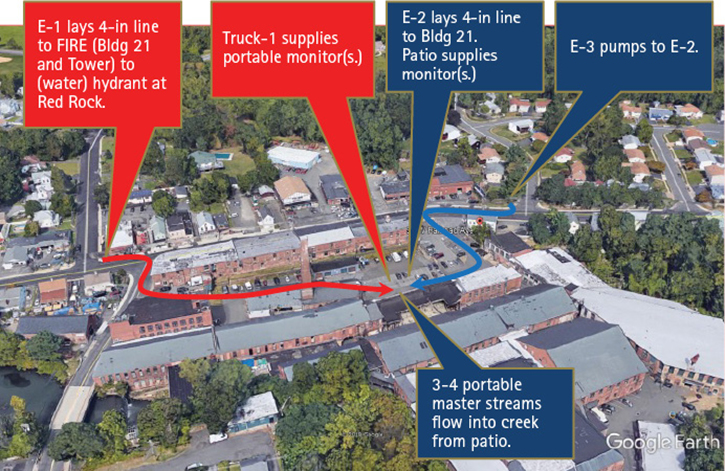
Use aerial photos to plan, train on, and execute high-flow operations. A picture is worth a thousand words.
The planning effort in coordination with the water company revealed that the next closest water district (a different supply system) was a half-mile away. A comprehensive mutual-aid large-volume water movement plan was developed, tested, and put on the shelf for that bad night when fire is through the roof and the entire neighborhood is threatened. Partnering with your water supplier is at least a near essential task, if not essential.8
Evaluate Options
Engine company leaders often have to evaluate hose loads, target flows, and other tactical and nontactical decisions. The tool in Figure 4 consisting of a simple matrix and rating options 0-3 may help in your decision making. Although it obviously is not a fireground tool, it is a real help administratively.
Figure 4. Option Evaluation Tool
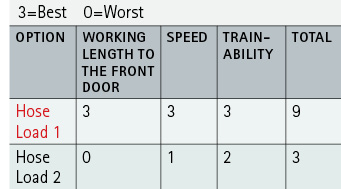
Source: Author
Across the top of the Option Evaluation Tool, enter important characteristics of the issue—in this case, three hoseline factors. You can have as many factors as you think necessary. Rate each hose load on a 0-3 scale. Zero is completely no value, 1 is some value, 2 is high value, and 3 is the highest score. This method can be used for almost any decision and works well with a committee approach. The high score wins. Of course, you don’t have to go simply by score. Just use it as an indicator of the relative value of the options.
Managing the SEC is a huge task. The mission-essential task list tools presented here will help you lead your company to tactical successes on the fireground and maximize safety for your members.
References
1. Army FM-25-100, Ch 2, accessed online.
2. Flatley, C, J Knapp, T Pillsworth, “Testing Your Target Flow,” Fire Engineering, Oct. 2006.
3. Pillsworth, T, J Knapp, C Flatley, D Leihbacher, “Nozzle Reaction Simulator Can Improve Fire Attack Skills.” Fire Engineering, Oct 2007.
4. Pillsworth, T, J Knapp, C Flatley, D Leihbacher, “How Kinks Affect Your Fire Attack System, Fire Engineering, Oct. 2007.
5. Kerber, Steve, Report on Structural Stability of Engineered Lumber in Fire Conditions, UL Firefighter Safety Research Institute, 2008.
6. Knapp, J, “Fire Envelopment at Private Dwelling Fires,” Fire Engineering, May 2015; emberly.fireengineering.com/2015/05/15/225681/jerry-knapp-fire-envelopment-at-private-dwelling-fires/.
7. Gallagher, Kevin A., “Modular Construction: Do we have a problem?” Fire Engineering, Sept. 18, 2013; https://emberly.fireengineering.com/2013/09/18/195048/modular-concerns-do-we-have-a-problem/.
8. Knapp. Jerry, “How to Plan and Execute A Large-Scale Training Drill”, March 2019; https://emberly.fireengineering.com/2019/03/21/193370/how-to-plan-and-execute-a-large-scale-training-drill/.
JERRY KNAPP is a 44-year veteran firefighter/emergency medical technician with the West Haverstraw (NY) Fire Department; a training officer at the Rockland County Fire Training Center in Pomona, New York; chief of the Rockland County Hazardous Materials Team; and a former nationally certified paramedic. He has a degree in fire protection; is the co-author with Chris Flatley of House Fires (Fire Engineering); wrote the “Fire Attack” chapter in Fire Engineering’s Handbook for Firefighter I and II (Fire Engineering); and has authored numerous articles for fire service trade journals.

